| FAQ |
| Members List |
| Social Groups |
| Calendar |
| Search |
| Today's Posts |
|
#1
|
||||
|
||||
|
I thought I'd post a few pictures and some info concerning the differences between the '73 -'74 455 Super-Duty, '68 Ram Air II 400, '69 -'70 Ram Air IV 400, '71 -'72 455 HO round-port heads and the more common D-port Pontiac heads for those who may be somewhat unfamiliar with them.
Pictured at the top is a 1969 #722 Ram Air IV 370 HP 400 round-port head, below a 1970 #13 D-port 350 HP 400 head. The exhaust ports on the RAIV head are pretty much perfectly round so it's easy to see why they're called round-ports by the Pontiac hobbyists. The two D-shaped center exhaust ports on the #13 head give them their D-port nickname, these are without a doubt the most common Pontiac heads as easily 99.999% of all Pontiac V8 cars left the factory equipped with D-ports. The round exhaust ports are much easier to make headers for, getting the bolts started and putting a wrench on them is a lot easier too. All round-port Pontiac engines were equipped with free-flowing Ram Air or HO exhaust manifolds with no exceptions. 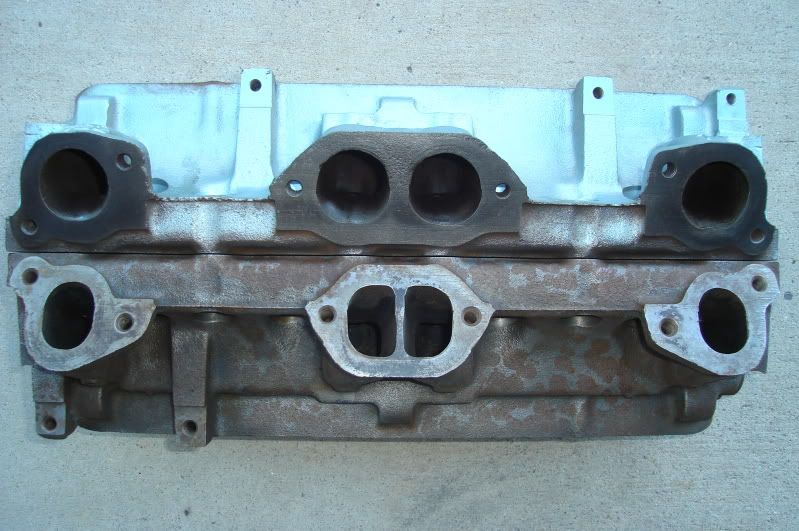 Under the valve covers there are some differences that aren't easy to notice. The '69 -'70 RAIV are the only round-port heads to come from the factory equipped with 1.65:1 ratio rockers, so in this particular instance there are larger clearance holes for the pushrods that are also located closer to the rocker stud bosses. The pushrod cups in the 1.65:1 rockers are located closer to the pivot ball than on 1.5:1 rockers. Added clearance is provided for the slightly different location of the pushrod as well as the slightly larger 11/32" diameter pushrods used by the RAIV, as compared to the 5/16" diameter standard pushrods. The tapped rocker stud bosses on the RAIV are separate, the bosses on the #13 head are paired together with enough material cast in the center area so that an additonal bolt hole can be tapped. This tapped hole would only be used on a press-in stud version of this type of D-port head casting, to fasten the pushrod guide plates. Screw-in rocker studs will retain the guideplates on the #13 head, as well as on the RAIV. Looking closely at the RAIV head you can see the center head bolt boss under the valve cover has been machined right through the date code. You can still see the casting impression of the two slotted-head screws on either side of the bolt boss used by the foundry to retain the date code tag. None of the regular production round-port heads will have a casting date code that's visible, only the service replacement heads will. Round-port heads also use 3 longer head bolts next to the exhaust ports, as compared to their D-port cousins. 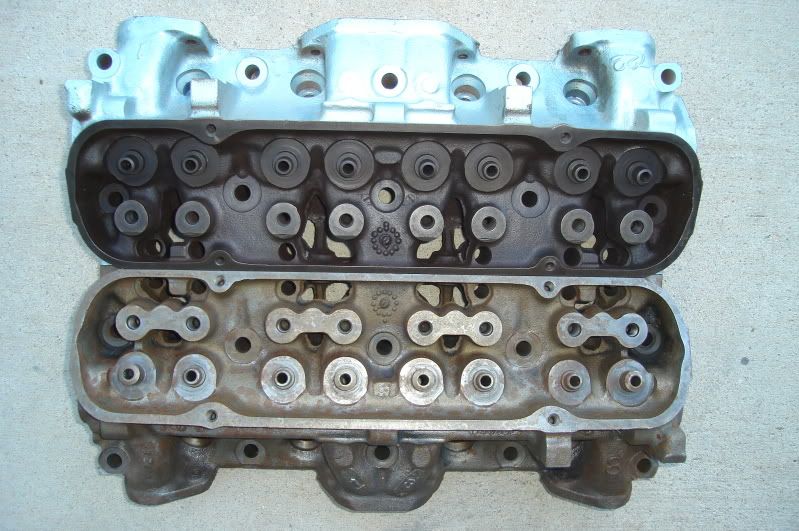 The RAIV uses some very unique valvetrain pieces, shared only with the '68 RAII #96 round-port heads. Going from the bottom of this pic are the special 11/32" pushrod guideplates, straight 7/16" screw-in rocker studs, long hex valve adjusting nuts, short hex locking nuts, stamped steel rocker arm oil drippers and finally stamped steel retaining nuts for the drippers. An adjustable valvetrain was used on the RAIV and RAII engines, again unique among Pontiac V8s with hydraulic lifter camshafts. The long 7/16" hex nut and the short locking nut were used to make and set the adjustment, as opposed to just torquing the standard 3/8" rocker nuts down to 20 ft. lb. onto the tapered shoulder of the standard 'bottleneck' rocker studs used on common D-port heads that used non-adjustable valvetrains. The '73 -'74 455 SD heads and the '71 -'72 455 HO heads also used 'bottleneck' studs and non-adjustable valvetrains. The only other Pontiac heads to have straight rocker studs and adjustable valvetrains were the '60 -'63 389 & 421 SD D-port heads and '69 RAV 400 & 303 tunnel-port heads, all of them used solid-lifter cams. The RAIV uses unique 1.65:1 stamped steel rockers for .517" lift with the factory '041' cam (will take a pic of them later after I dig them out), the RAII uses common 1.5:1 rockers (.470" lift with the '041' cam that was first used on the RAII). 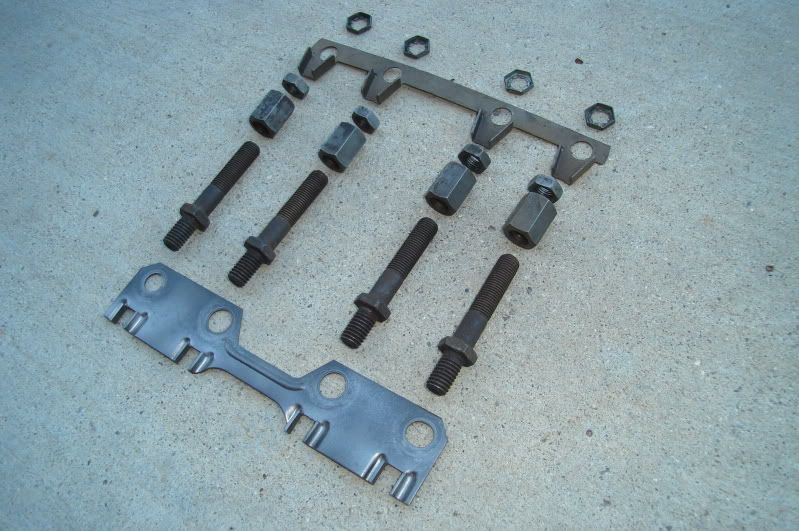 On the combustion chamber side we have another big difference in design between the round-port head and the D-port. Both have 2.11"/1.77" valves and open chambers, but there is a unique 'spherized wedge' chamber design shared by all of the round port heads. 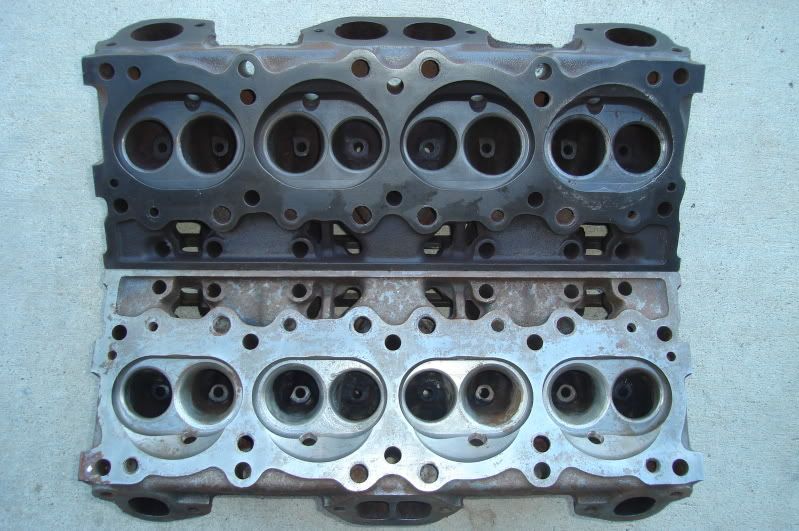 The intake side is where we see a major difference in port entrance roof height. The RAIV head has a .150" taller port as compared to the #13 head. Port entrance dimensions are 2.220" x 1.110" for the RAIV and 2.070" x 1.100 for the #13 head, the port floor is at the same height in relation to the head deck for both heads. Not only is there a difference in port entrance size, the RAIV port has added volume and is shaped to flow at higher valve lifts, designed to work with the factory .517"' valve lift '041' hydraulic cam. 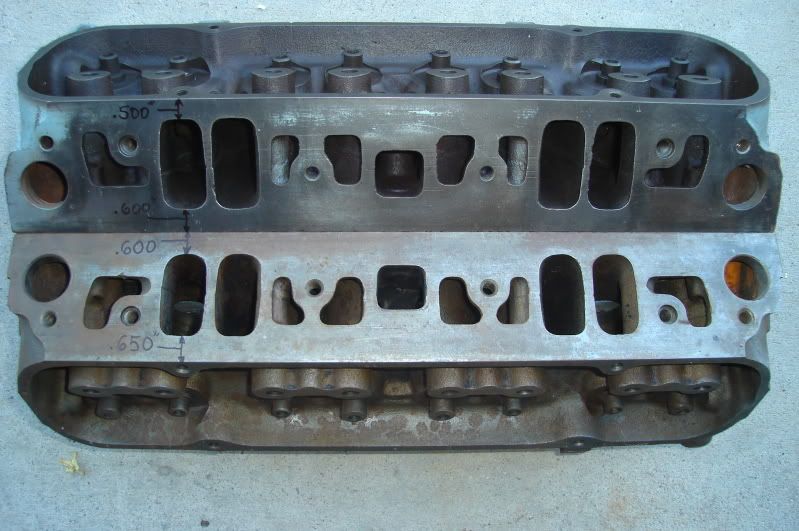 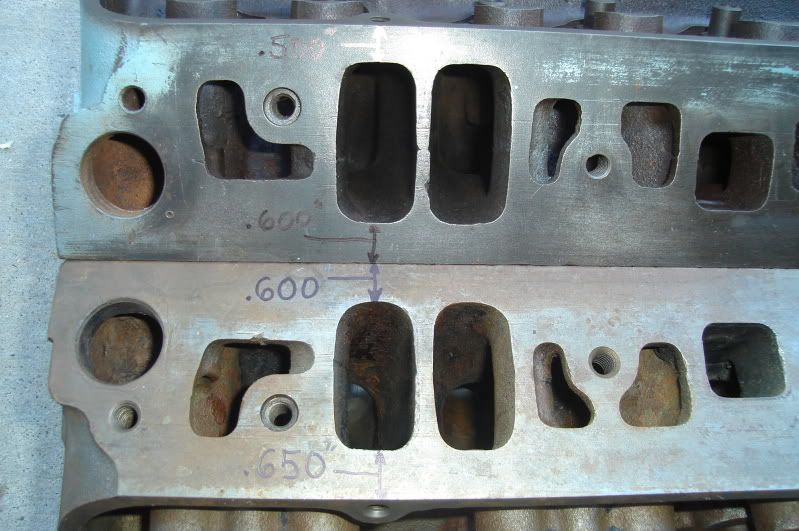 It's easy to see why Pontiac enthusiasts covet the RAIV heads as well as any of the other round-port heads. It's true that common D-port heads can be easily worked to flow just as well as or even better than the round-port heads, but it's great to have a pair of these rare Pontiac performance heads under your hood. 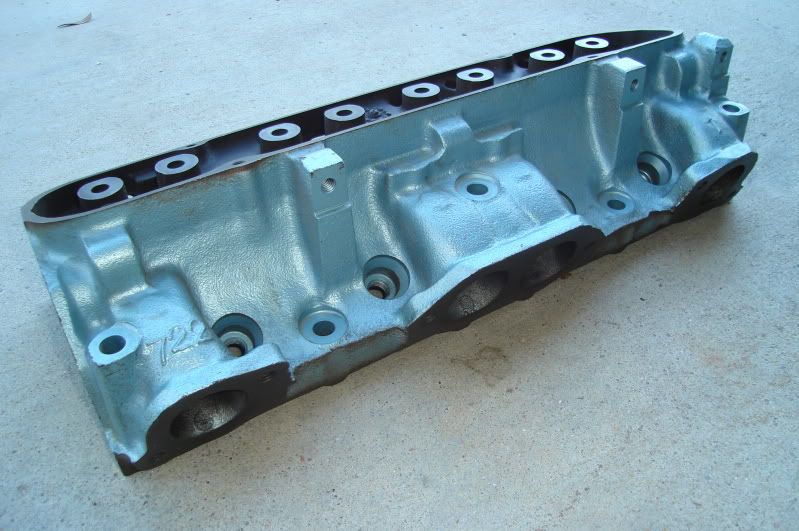 Hopefully this post will answer some of the questions on the minds of Pontiac hobbyists and help to better illustrate both the obvious and subtle differences between these two Pontiac V8 head designs. |
|
#2
|
||||
|
||||
|
Thanks...thats good info in a neat comparison set of pics. Appreciated.
__________________
Regards, Leigh Pontiacs I’ve owned…. 1960 Laurentian 283 1963 Laurentian 283 1976 Trans Am 400 1977 Trans Am 400 1951 Chieftain Flat head 6 1967 Firebird 400 convertible 1967 Firebird 400 coupe 1979 Trans Am 403 1971 Formula 455 (clone) 1969 Firebird 350 1968 Firebird 428 manual. Sydney, Australia |
|
#3
|
||||
|
||||
|
One other area that gets important using RAIVs with a bigger cam is the distance from the valve edge to the deck as it affects Valve-Piston clearance numbers. Since the RAIV chamber is larger in diameter "spherized wedge" but still only 72cc it is shallower so the valves are closer to the deck and pistons but a significant amount. I had the measurment compared to a 62 head somewhere but forgot it, somewher here in a old post. It is even greater when compared to a deep chamber low compression head like a 6X. Even the 72cc E heads have a slightly deeper chamber.
The #614 service replacement heads also have the boss for drilling that extra hole for the later model alternator/PS bracketry.
__________________
Skip Fix 1978 Trans Am original owner 10.99 @ 124 pump gas 455 E heads, NO Bird ever! 1981 Black SE Trans Am stockish 6X 400ci, turbo 301 on a stand 1965 GTO 4 barrel 3 speed project 2004 GTO Pulse Red stock motor computer tune 13.43@103.4 1964 Impala SS 409/470ci 600 HP stroker project 1979 Camaro IAII Edelbrock head 500" 695 HP 10.33@132 3595lbs |
|
#4
|
|||
|
|||
|
Do round ports headed engines require less advance than d-port headed engines ? Always wonder if the round port chamber was a better set up than what the d-port chamber is.
|
|
#5
|
||||
|
||||
|
Also note on the 722 head how the factory made the mistake of located the casting date plate where it got machined away by the center head bolt pad nearest the Exh crossover passage.
__________________
Wernher Von Braun warned before his retirement from NASA back in 1972, that the next world war would be against the ETs! And he was not talking about 1/8 or 1/4 mile ETs! 1) 1940s 100% silver 4 cup tea server set. Two dry rotted 14 x 10 Micky Thompson slicks. 1) un-mailed in gift coupon from a 1972 box of corn flakes. Two pairs of brown leather flip flops, never seen more then 2 mph. Education is what your left with once you forget things! |
|
#6
|
||||
|
||||
|
Great! Thanks so much!
__________________
69 Gto, 390 posi gears,th400 w/jim hand converter/406 pontiac/#64 HEADS/ 10:1 compression/ 190 PSI with/ TRW 160 thou domes / hooker headers 1 7/8, PRW 1.5 rockers, 405 Crower Springs, Holley 750 vac with proform upgrade, Performer RPM on points / 284 H Single Pattern Crane |
|
#7
|
||||
|
||||
|
cool info, thanks.
although this really stuck out at me--- None of the regular production round-port heads will have a casting date code that's visible, only the service replacement heads will. so i guess that means there's no real way to tell if a round port car is truly numbers matching? they can be verified matching as far as head code goes, but dating them cant?
__________________
costs too much |
|
#8
|
||||
|
||||
|
Quote:
Quote:
|
|
#9
|
||||
|
||||
|
The '68 -'74 round-port heads all had their own unique features, here is a breakdown of most of the main differences:
1968 Ram Air II 400 heads (casting # 96, 72cc chambers, factory rated at 10.75:1 compression) had standard-sized intake ports and used the same cast iron Q-jet intake manifold as the standard 4-barrel D-port engines that year. Rocker studs were straight 7/16", pushrods were 11/32" diameter, 1.5:1 rockers, valves were 5.20" tall tuliped and swirl-polished, springs were 1.776" installed height. First use of the 9794041 cam (.470" lift w/1.5 rockers), most commonly known as the RAIV cam even though the RAII introduced it. 1969 Ram Air IV 400 heads (casting # 722, 72cc chambers, factory rated at 10.75:1 compression) had .150" taller intake ports and used a tall-port aluminum Q-jet intake with a separate cast iron exhaust crossover. Rocker studs were straight 7/16", pushrods were 11/32" diameter, 1.65:1 rockers, valves were 5.20" tall tuliped and swirl-polished, springs were 1.812" installed height, 9794041 cam (.517" lift w/1.65 rockers). 1970 Ram Air IV 400 heads (casting # 614, 72cc chambers, factory rated at 10.75:1 compression) had the same basic features as the 1969 # 722 heads, the intake port was redesigned some for improved flow. 1971 455 HO (High Output) heads (casting # 197, 111cc chambers, factory rated at 8.4:1 compression) had the same intake basic taller port dimensions at the intake manifold as the RAIV. The deeper 111cc chamber changed the actual port shape, they work well at the lower valve lift (.407") of the 9779068 455 HO cam. Rocker studs were standard bottle-neck (3/8" top threads, 7/16" shank), pushrods were 5/16" diameter, 1.5:1 rockers, valves were 4.96" tall standard flat valves, springs were 1.590" installed height. Intake manifold was of the same design as the RAIV, sand cast instead of precision cast like the RAIV. 1972 455 HO (High Output) heads (casting # 7F6, 111cc chambers, factory rated at 8.4:1 compression) were close to the same as the 1971 # 197 heads with a couple of small differences. The exhaust ports were more restrictive and the intake ports had the divider between each pair of ports at the intake surface milled down by about 1/8". The intake manifold was now slightly more restrictive due to the raised plenum floor that made room for the now riveted-on exhaust crossover heat shield. 1973 & 1974 455 SD (Super Duty) heads (casting # 16, 111cc chambers, factory rated at 8.4:1 compression) had an even larger intake port than the RAIV heads, it was both taller (by about .040") and wider. The intake port was widened by removing material from the pushrod bulge and pressing in a thin .030" wall tube to seal off the pushrod hole. The intake valve seats were cut at 45-degrees unlike the 30-degree intake seats in the other round-port and standard heads, the exhaust valve seats are actually hardened inserts. Rocker studs were standard bottle-neck (3/8" top threads, 7/16" shank), pushrods were 5/16" diameter, 1.5:1 rockers, valves were 4.98" tall tuliped and swirl-polished, springs were 1.812" installed height. The intake manifold was a one-piece cast iron tall-port unit specific to the 455 SD and was equipped with EGR. Camshaft was the 493323 (.407" lift) which has the special small-diameter 455 SD & RAV distributor drive gear, it had the same lobe profile as the 9785744 Ram Air cam which is commonly called the RAIII cam. |
|
#10
|
|||
|
|||
|
Great info thanks for sharing.
__________________
Conrad 79 Trans AM 406 #12 heads Torker II intake Crower 60210 750 holley vac. sec. T400 3500 Stall 3:73:1 rear.  ECMTTFMFers. IHTTFMFers. ECMTTFMFers. IHTTFMFers.
|
|
#11
|
|||
|
|||
|
Anyone know what does the D281 stamp mean?
|
|
#12
|
||||
|
||||
|
__________________
Bill 64 GTO, tube chassis w/606" IA tall deck, PG & a pro geared Fab 9". 2750 lbs. 8.2550@164.17-1/4, 5.2901@131.97-1/8, 1.1981-60-ft. 8/10/08 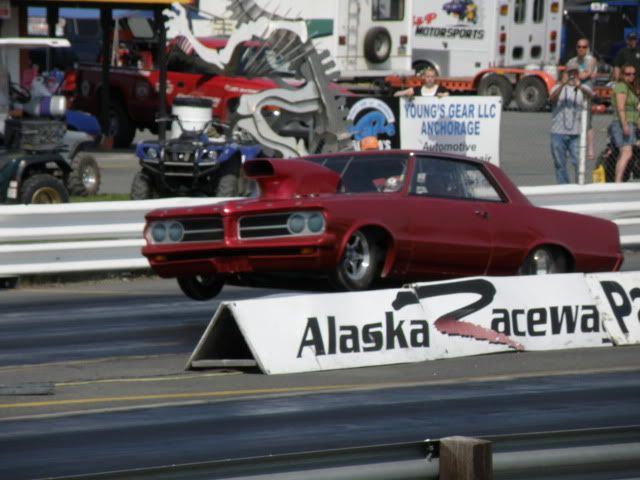
|
|
#13
|
|||
|
|||
|
Hello all,one of my pairs of RamIV's was bought over the counter in the mid 70,s .One head has the 614 casting and the other has 722 ground off and 614 stamped in.

|
|
#14
|
|||
|
|||
|
Quote:
|
|
#15
|
|||
|
|||
|
Read all of the above... a few notes, only the production 722's, production 614's and the pre Fall strike (early production) cast 197's didn't have external dates cast into them, their original date code was machined off when bolt hole was spot machined for center head bolt. '68 Ram II's had dates cast externally, both original dates and dates cast as service replacements.
After the Pontiac foundry came back on line after he Fall of '70 strike in November, one of he first things they cast were SR 614's. Those SR 614's will have mid Nov 70 dates externally, they also had a pair set of rocker bosses only on one end of the head. The late style 197 heads also had this feature. the Dec date, L080, seems to be first date on the late 197's. Many times more often than not an L080 head was paired with an A080 head thorough the winter and into the Spring of '71. For '72, both the early and late styles of 7F6's will have external dates.
__________________
Buzzards gotta eat... same as worms. |
|
#16
|
||||
|
||||
|
I just noticed the question about timing my RAIVs like 32-34, my D port motors have generally liked more.
My SR are dated J294, K114. The K casting one roof of an end exhaust port actually had a hole in it we had to weld . I bought them new from a local Pontiac guy who had worked a a dealership.
__________________
Skip Fix 1978 Trans Am original owner 10.99 @ 124 pump gas 455 E heads, NO Bird ever! 1981 Black SE Trans Am stockish 6X 400ci, turbo 301 on a stand 1965 GTO 4 barrel 3 speed project 2004 GTO Pulse Red stock motor computer tune 13.43@103.4 1964 Impala SS 409/470ci 600 HP stroker project 1979 Camaro IAII Edelbrock head 500" 695 HP 10.33@132 3595lbs |
|
#17
|
||||
|
||||
|
Quote:
But I'm at low compression now.
__________________
12.24/111.6MPH/1.76 60'/28"/3.54:1/SP-TH400/469 R96A/236-244-112LC/1050&TorkerI//3850Lbs//15MPG/89oct Sold 2003: 12.00/112MPH/1.61 60'/26"x3.31:1/10"/469 #48/245-255-110LSA/Q-Jet-Torker/3650Lbs//18MPG 94oct Sold 1994: 11.00/123MPH/1.50 60'/29.5"x4.10:1/10"/469 #48/245-255-110LSA/Dual600s-Wenzler/3250Lbs//94oct |
|
#18
|
||||
|
||||
|
Great info B-man. Thanks for sharing.
Charles
__________________
68 Firebird. IA2 block, 505 cu in, E-head, Solid roller 3650 weight. Reid TH400 4:11 gear. 29" slick. Best so far 10.12@133 mph. 1.43 60 ft. 76 Trans am, TKX .81 o/d, 3.73 Moser rearend, 468 with KRE D-ports, Doug headers, 3" Exh. |
| Reply |
|
|